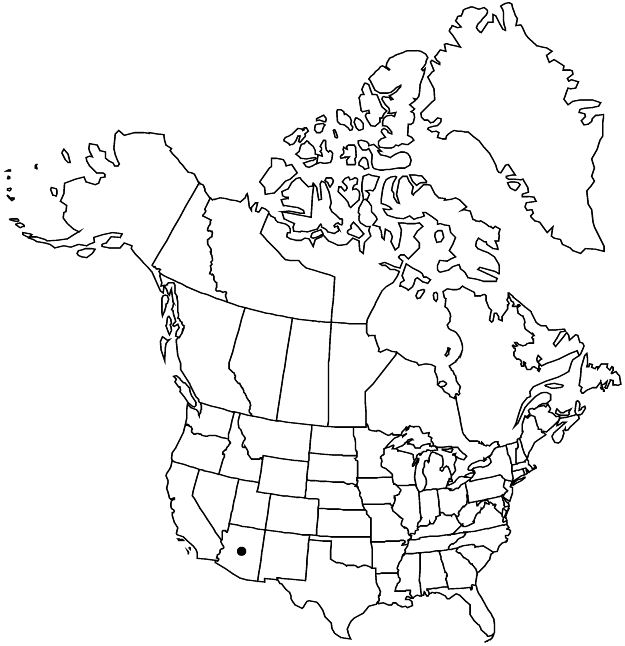Difference between revisions of "Argythamnia brandegeei var. intonsa"
Trees & Shrubs Southw. Deserts, 394. 1954.
FNA>Volume Importer |
FNA>Volume Importer |
||
| Line 26: | Line 26: | ||
|elevation=100–400 m. | |elevation=100–400 m. | ||
|distribution=Ariz.;Mexico (Baja California Sur;Sonora). | |distribution=Ariz.;Mexico (Baja California Sur;Sonora). | ||
| − | |discussion=<p>Argythamnia brandegeei var. brandegeei is endemic to Mexico and usually is glabrous, although a few inconspicuous hairs are present on a fruit of the isotype: T. S. Brandegee s.n. (UC). In contrast, var. intonsa has hispidulous ovaries and capsules, and usually pubescent stems and leaves.</p> | + | |discussion=<p><i>Argythamnia brandegeei</i> <i></i>var.<i> brandegeei</i> is endemic to Mexico and usually is glabrous, although a few inconspicuous hairs are present on a fruit of the isotype: T. S. Brandegee s.n. (UC). In contrast, <i></i>var.<i> intonsa</i> has hispidulous ovaries and capsules, and usually pubescent stems and leaves.</p> |
|tables= | |tables= | ||
|references= | |references= | ||
| Line 50: | Line 50: | ||
|publication year=1954 | |publication year=1954 | ||
|special status= | |special status= | ||
| − | |source xml=https://jpend@bitbucket.org/aafc-mbb/fna-data-curation.git/src/ | + | |source xml=https://jpend@bitbucket.org/aafc-mbb/fna-data-curation.git/src/8f726806613d60c220dc4493de13607dd3150896/coarse_grained_fna_xml/V12/V12_193.xml |
|genus=Argythamnia | |genus=Argythamnia | ||
|species=Argythamnia brandegeei | |species=Argythamnia brandegeei | ||
Revision as of 15:44, 18 September 2019
Herbs or shrubs, perennial, monoecious, to 15 dm. Stems erect, sparsely hairy, sometimes glabrescent, hairs malpighiaceous. Leaves: stipules deciduous or sometimes persistent, subulate, 0.4–0.6 mm, margins not glandular; petiole 7–18 mm; blade elliptic to oblong, 4.5–9.6 × 0.9–2.9 cm, margins serrulate to serrate, without glands, surfaces sparsely hairy, sometimes glabrescent, hairs malpighiaceous. Inflorescences bisexual, 1.5–5.5 cm; bracts elliptic to ovate, 1.5–2.2 mm, margins without glands. Flowers without pink dye when wetted. Staminate flowers: sepals lanceolate, 4–6 × 0.8–1 mm; petals elliptic, 5–7 × 1.2–2.5 mm, adnate to androphore; nectary glands ovate to elliptic, 0.5–0.7 × 0.3–0.5 mm, adnate to or free from androphore, glabrous; stamens 10, staminodes 0–3, glabrous. Pistillate flowers: sepals lanceolate, 5.5–9 × 1.5–2.5 mm, without glands; petals 5, elliptic, lanceolate, or rhombic, 5–6 × 1.5–1.6 mm; nectary glands oblate, 0.7–1 × 0.9–1.3 mm, glabrous; ovary hispidulous; styles 2.4–4 mm, glabrous; stigmas flattened. Capsules 4.5–7 mm, hispidulous. Seeds 3–4 mm, smooth or rugose.
Phenology: Flowering year-round.
Habitat: Desert scrub, rocky soils.
Elevation: 100–400 m.
Distribution

Ariz., Mexico (Baja California Sur, Sonora).
Discussion
Argythamnia brandegeei var. brandegeei is endemic to Mexico and usually is glabrous, although a few inconspicuous hairs are present on a fruit of the isotype: T. S. Brandegee s.n. (UC). In contrast, var. intonsa has hispidulous ovaries and capsules, and usually pubescent stems and leaves.
Selected References
None.